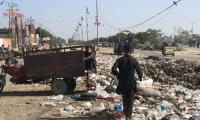Urban planners and designers are currently faced with a series of immense challenges. On the one hand, the world is experiencing a surge in population growth and its subsequent concentration in urban centres. On the other, climate change is also fast becoming a force to be reckoned with.
These problems are simultaneously conflicting and interlinked. Resolving them will have a direct impact on economic vitality, interconnectedness of citizens, and the longevity of cities.
Utility networks – consisting of water, waste, electricity, gas, and telecommunication systems – underpin the economic, social, and environmental performance of modern life. These fundamental necessities are the conduits through which modern cities operate.
Unfortunately, few cities in Pakistan can claim to be ‘planned’ cities, and those that can are also being affected by urban sprawl, finding it hard to regulate the way these spaces are structured. While all the cities in Pakistan were designed against ‘master plans’, it seems that currently Islamabad is the only city which continues to follow it. However, recent developments in its outskirts, especially housing schemes being constructed in potential violation of bylaws, is steering the system towards the direction that other cities have taken.
Karachi is also expanding without any method to the madness. Various estimates peg the population between 16.1 million and 20 million people – a sizable chunk of the country’s population and also the province’s. In 1947, when Karachi was Pakistan’s capital, its population was about 450,000 people. However, the population rapidly grew with a large influx of Muslim refugees after Partition in 1947. By 1951, the city’s population had crossed the one million mark. Today, the city has grown 60 times its size in 1947, and estimates suggest a continued growth at about five percent per annum, largely due to its strong economic base.
The biggest consequence of this mushroom growth was the burden on civic infrastructure. In the absence of any checks and balances, our urban resilience – the capacity of a city to act efficiently enabling residents and the workforce to endure stresses or shocks – has been steamrolled in favour of multi-storey constructions in areas that were not built to support them. In such cities that are less resilient and have weak governance systems, it is difficult for various utilities to perform efficiently.
Water services in Pakistan’s major cities and urban centres remain fragmented and intermittent. No city currently has 24 hours of water supply for seven days a week. This impairs the ability of cities to support economic growth and meet basic needs. Unplanned constructions and violations of zoning limits also overwhelm the existing resources. Drains meant to evacuate sewerage from a house with five residents are suddenly dealing with 20 members.
Water lines remain dry because the authorities were unable to build enough capacity, giving way to cartels which control water supply. All the research and study on the current situation of the supply of water in major cities like Karachi point towards a need for effective reform in the overall system to improve sources, supply, and sustainability of infrastructure.
The same dilemma is noticed in the electricity sector, another fundamental necessity in today’s age. Constructions in the outskirts of the city are often seen to be violating approved building plans, extending upper floors out onto streets and usurping public spaces and even nullahs meant to extract water away from urban centres towards the sea. Utilities are under intense scrutiny and must jump through several hoops under Karachi’s governance structure to acquire permissions to lay down electricity wires and cables.
The writer is a faculty member at the Department of Architecture and Planning at Dawood University of Engineering and Technology.
After November 30, it will be impossible for ordinary internet users to access all banned websites, including X
Muslims participated alongside their Hindu fellow villagers and other residents of area
For last eight years, HEC's budget has been virtually stagnant in absolute terms
Home to 14 million people, Lahore has always been celebrated as Pakistan’s historical, culinary, and cultural hub
Partnership between Pakistan and China in media and culture reflects shared commitment to strengthening bilateral...
This article focuses on single error committed by our respected judiciary which haunts me more than I would care to...







